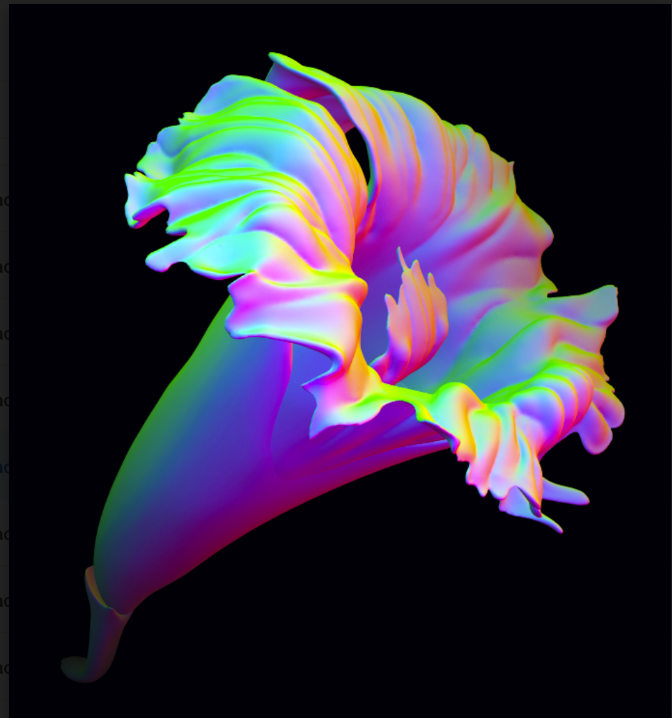Norris Center Art-Science Residency Complete Projects 2020 & 2019
Streets to Housing
By: Adam Millard-Ball (Professor, Environmental Studies) and Erin Single (Graduate student, Digital Arts and New Media)
Excess street space provides a potential way to mitigate the housing crisis facing coastal California cities and other urban centers. Residential lots might be extended into the existing street to create space for an accessory dwelling unit or a place to park a tiny home on wheels. Some streets might be able to host camper van parking. Others that are particularly wide or surplus to transportation needs might be turned into permanent housing. This project assess the practical feasibility of turning streets into housing, through case studies of urban design possibilities on streets in San Jose and Santa Cruz. The collaboration provides a way to explore the physical potential of specific sites, and the images will convey the possibilities to a wide variety of public, academic, and urban planning audiences.

Project Ayniqucha: A Participatory Strategy for Improvement of Artisinal Fisheries in Peru
By: Juan Carlos Jeri (Master's Student, Coastal Science and Policy) and Claire Cook (UCSC undergraduate)
Project Ayniqucha proposes a participatory approach to support and assess sustainable artisanal fisheries in Peru. We propose a new assessment tool to identify risks and challenges for the sustainability of artisanal fisheries. The project also aims to highlight the role of small scale fishers as experts of the ocean and key stakeholders for its protection. In that sense, we named this project “Ayniqucha”, which combines the words for collaborative communal work (ayni) and ocean (mama qucha) in the indigenous Quechua language. We propose to use art as a critical tool for communicating the goals and results of the project. Through the Norris Center Art-Science Residency Project and in collaboration with the artist Claire Cook, we created eleven illustrations to support the project. First, the main illustration of the project that depicts the knowledge that fishers have on the marine ecosystem. Then, a series of illustrations for a diagram of the different steps and elements of the project (i.e. data collection in artisanal fisheries, data processing, and expected results). Finally, the collaboration also resulted in the creation of a logo for the project and a model of a flyer.

California Coastal Plant community Interpretive Signs
By: Spencer Klinefeleter (Santa Cruz Museum of Natural History) and Nina Scherer
The Santa Cruz Museum of Natural History worked with artist Nina Scherer to illustrate various representative plant communities found around the central coast of California and that are present in the museum gardens. The Museum has worked to redesign and enhance the surrounding space to cultivate native plant species and support the ecologies of pollinators, birds, and beneficial insects, all with the goals of educating the public and protecting local biodiversity. Each sign was originally done in watercolor and then interpretive text was added to each, highlighting key relationships and features particular to each local habitat. The signs are to be placed around the museum gardens, located in Tyrrell Park across from Seabright Beach, and will be used in school and community education programs, and will be viewable by the general public who walk through the neighborhood park.
The main goal of these signs is to interpret the unique characteristics of several local vegetation communities that are often hidden or overlooked by many people, including the complex root systems of native plants, and the diversity of pollinators that visit flowers throughout the year. These interpretive signs will support the ongoing work by the Museum to enhance its surrounding landscapes to better support the Museum's mission to connect people with nature to inspire stewardship of the natural world.
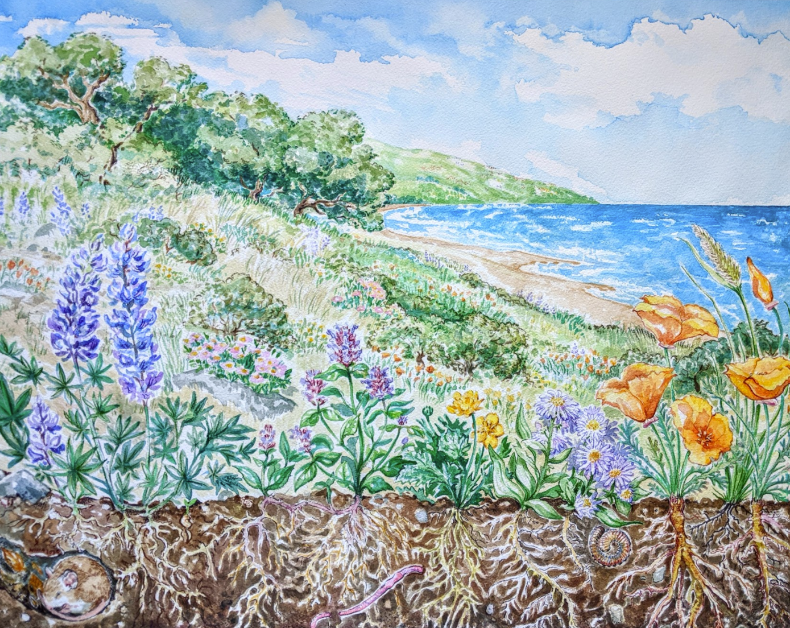
Visualizing the Subsurface
By: Amanda Donaldson (PhD student, Earth and Marine Sciences) and Linnéa Gullikson (undergraduate, Ecology and Evolutionary Biology)
Our limited understanding of subsurface water movement is, in large part, due to the difficulty to access the subsurface to characterize soil and rock properties. Geophysical techniques such as seismic refraction provide two-dimensional information on subsurface seismic velocities that can reveal subsurface geologic features that exert a primary control on water movement and storage. Doctoral Student Amanda Donaldson worked with Ecology and Evolutionary Biology Undergraduate Linnéa Gullikson to improve our ability to conceptualize and communicate the subsurface physical structure by combining geophysical imagery with art to visualize the subsurface. For this residency, Gullikson created two products: 1. a watercolor abstract of vegetation within Arbor Creek Experimental Watershed (San Jose, CA) across the winter (dormant) and summer (growing) seasons and 2. digital illustration of Arbor Creek’s subsurface interpreted from geophysical surveys and in-situ boreholes. This residency allowed us to bring science and art together to holistically conceptualize the structural interactions and boundaries between vegetation, soil, weathered rock, and bedrock. The products of this art residency will serve as the foundation of conceptual models of water movement and storage in Arbor Creek Experimental Watershed.
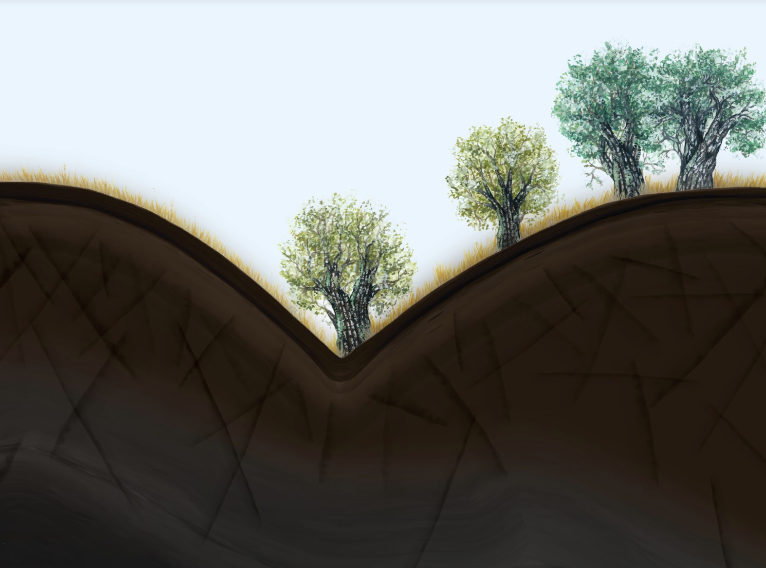
The Zonation of Aquatic Life in Riffles and Pools of Streams
By: David Herbst (Research Scientist, Institute of Marine Sciences) and Rae Taylor-Burns (PhD student, Ocean Sciences)
Getting an understanding of what goes on unseen beneath the water surface is an important part of using interpretive exhibits for aquatic environments. Unless you can get your head underwater, it is difficult to see this aquatic world. Museums and aquariums often have displays of how rising and falling ocean tides establish life zones in rocky intertidal environments that form habitats for a diverse array of life. Streams and rivers also show zonations of life with depth in riffles and pools that form along shallow to deep profiles as water flows downstream, but these are typically absent from interpretive exhibits. Collaboration of scientist David Herbst and artist Rae Taylor-Burns has resulted in a series of 26 multi-panel stream bug and waterscape paintings that represent stream channel habitats as an underwater view into how aquatic insects “go with the flow” of water through riffles and pools. The types of stream bed, light levels, algae films, leaf, wood, rock and sediment deposits, plunge pools, lateral bars at bends, are all represented. Featuring selected stream insects superimposed on the waterscapes of stream habitat, the paintings also show variations in form and structure of habitat and inhabitants under a dynamic flow regime of flood to drought. How water movement and habitats shift in proportion to current velocity over time represents between-year or seasonal changes in flow. Responses of invertebrates to flow are shown as variations in the abundance of species selected to represent classic pool and riffle fauna and their differing natural histories. Large paintings (2x3 ft) illustrate overviews and cross-sections of stream profiles showing how geomorphic and life zones are organized. This work communicates scientific findings of how stream life is distributed by habitat type and as drying occurs, providing a clear view of features shaping stream ecology and how climate change and drought impinge on aquatic ecosystems. From somewhat obtuse graphs and tables of research papers, this project has produced an effective visualization that vividly exhibits how streams work and can be used as an education tool in a variety of settings.
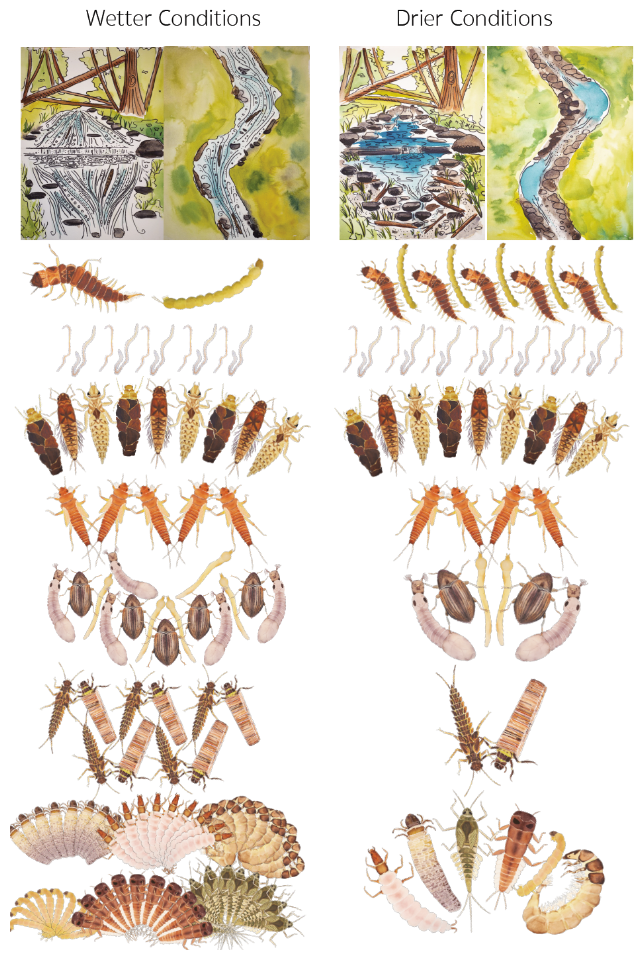
Finding Nemo Through a Queer Lens: This Time With the Correct Biology
By: Paloma Medina (PhD Student, Biomolecular Engineering) and Jessie Kendall-Bar (PhD Student, Ecology and Evolutionary Biology)
Finding Marla is a reimagination of Finding Nemo through a Queer lens. In reality and off the big screen, clownfish like Nemo and Marlin are sequential hermaphrodites and transform from male to female when the matriarch of their colony is removed, such as by death. Once Nemo’s Mother had left, Marlin, being the next biggest fish in the colony, would have transitioned to become the female matriarch. Through this residency, Ms. Medina and Ms.Kendall-Bar worked together to create the text and illustrations for the picture book Finding Marla. This book showcases the sexual diversity of the clownfish and gender diversity in nature.
Participating in the residency affected Ms. Medina’s teaching and research through supporting her interest by translating ideas from my research to positive messages that many people can have access to. The financial and artist-matching support from the Norris Center supported her passion for education and outreach. She learned that working with an artist was a challenging and good practice to use words and metaphors to communicate her research without jargon.
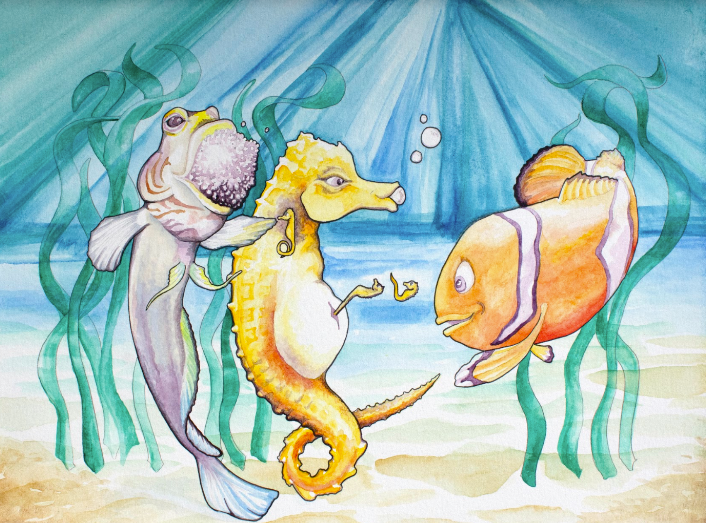
Testing Flower-Pollinator Co-Evolution Using Printed Artificial Flowers
By: Kathleen M. Kay (Professor, Ecology and Evolutionary Biology), Rossana Maguiña (PhD Candidate, Ecology and Evolutionary Biology), and Colleen Jennings (MFA student)
The participants in this art/science collaboration explored how changes in plant floral traits shift from one pollinator group to other, a process plays a role in the formation of new species. They used the neotropical spiral gingers (genus Costus) as a study system in Costa Rica and Peru. In this plant group, hummingbird pollination has evolved independently from orchid bee pollination many times over a couple million years. Flowers pollinated by orchid bees and hummingbirds differ in several floral traits, such as flower length, the presence of landing platform, the presence of visually contrasting nectar guides and flower color. The goal was to determine which of these traits attract or deter bees versus hummingbirds in order to understand how natural selection by those pollinator types could drive these pollinator shifts and cause speciation.
To answer this question, Dr. Kay and doctoral student Rossana Maguiña worked with Ms. Jennings to manipulate the floral traits of 3-D printed artificial flowers to quantify pollinator responses. Ms. Jennings designed and printed the artificial flowers that individually alter traits, such as the flower length, the presence/absence of a landing platform, the presence/absence of nectar guides, and the pale versus red overall color. These flowers were exposed to natural pollinators in the field and they analyzed pollinator’s foraging behavior. Pollinators did not visit 3D printed flowers in the field but they visit them in a cage (a controlled environment). They will continue to modify the materials used to try to create more realistic flowers to and test the pollinator response.
